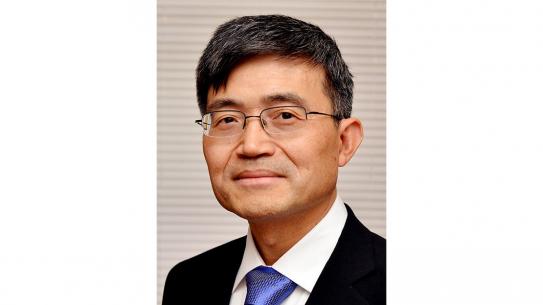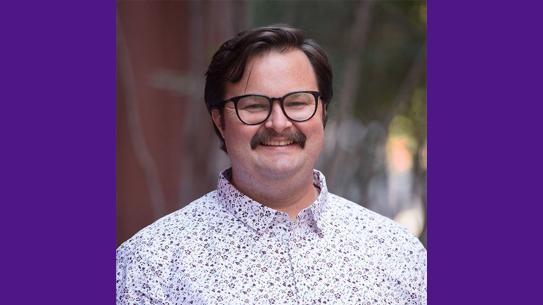What’s in the air?
NYU Tandon School of Engineering partners with real estate company Lendlease to create “buildings of the future” that can detect airborne viruses

People could soon be alerted to potentially deadly airborne threats — including pollutants, bacteria, and viruses — in schools, buses, and other indoor spaces, thanks to groundbreaking research underway at NYU Tandon School of Engineering.
NYU Tandon faculty members Elisa Riedo and Davood Shahrjerdi are working on developing sensors to detect pathogens in the air in places where they are installed.
The project is supported by Lendlease, an international property and infrastructure company, with an almost $1 million grant it provided to Riedo, a chemical and biomolecular engineering professor, and Shahrjerdi, an electrical and computer engineering associate professor, to provide resources to build the underlying technology and prototypes of the sensors. Lendlease develops large residential communities and mixed-use urban districts around the world.
The NYU engineering researchers aim to create a novel technological platform that detects the presence of airborne viruses and other hazards electronically, through the use of a special microchip that generates a digital signal when it interacts with an airborne threat.
Currently, the most reliable and widely used methods for detecting viruses rely on chemical analysis of physical samples, such as the polymerase chain reaction (PCR) test for COVID-19.
The research by Riedo and Shahrjerdi, along with other advancements in electronic virus detection, hold the promise of revolutionizing the field by offering more efficient and accessible methods of virus detection. This has far-reaching implications for both public health and biodefense. It could, for instance, facilitate the instant lockdown of buildings upon detection of a dangerous virus in the air, or prompt a rapid emergency response to airborne biological hazards.
Riedo and Shahrjerdi’s work with Lendlease intersects with a project the two started early last year with Mirimus, a Brooklyn biotech company, to develop a wearable electronic device that detects the presence of a virus in the wearer.
“As with Mirimus, Lendlease has afforded us an amazing opportunity to test the limits of our vision on how we can use electronic technology to create spaces that are safe and healthy for everyone, something particularly pressing given what we’ve all endured in recent years,” said Shahrjerdi.
“The Lendlease project is uniquely ambitious because of its technical complexity,” said Riedo. “The first hurdle is developing electronic technology that has the capacity to reliably and consistently sense airborne threats. The second challenge is making that technology function not just when a threat comes into contact with a device directly, but when it’s in the air at a distance from the device.”
“Collaborating with Elisa and Davood represents the boundless possibilities when private industry and academia join together towards goals that can deliver enormous benefits to people’s lives,” said Tommaso Boralevi, Innovation & Technology Director, Lendlease Italy. “The COVID-19 pandemic revealed the critical need for modernizing buildings with advanced technologies that can detect and counter novel public health threats in real-time. This deficiency in present-day buildings is largely the reason for reliance on basic risk-mitigation strategies in public spaces such as mask-wearing and entry passes. A sensing technology that allows sensitive, selective, and rapid detection of various public health threats is needed for realizing this vision for the ‘buildings of the future.’”
Through its interdisciplinary "areas of excellence" that guide its research and teaching, the NYU Tandon school of engineering is dedicated to pioneering technological solutions to pressing societal challenges. Riedo and Shahrjerdi’s work on electronic virus detection serves as a prime example of Tandon's focus on healthcare advancement, one of its foundational areas of excellence. Beyond wearable electronics and integrated biosensors, NYU engineers are performing other cutting-edge research at the boundary of nanoelectronics and medicine, for studying brain function and developing human augmentation technologies.
About the New York University Tandon School of Engineering
The NYU Tandon School of Engineering is home to a community of renowned faculty, undergraduate and graduate students united in a mission to understand and create technology that powers cities, enables worldwide communication, fights climate change, and builds healthier, safer, and more equitable real and digital worlds. The school’s culture centers on encouraging rigorous, interdisciplinary collaboration and research; fostering inclusivity, entrepreneurial thinking, and diverse perspectives; and creating innovative and accessible pathways for lifelong learning in STEM. NYU Tandon dates back to 1854, the founding year of both the New York University School of Civil Engineering and Architecture and the Brooklyn Collegiate and Polytechnic Institute. Located in the heart of Brooklyn, NYU Tandon is a vital part of New York University and its unparalleled global network. Learn more at engineering.nyu.edu.
About Lendlease
Lendlease (www.lendlease.com) is a leading international group in the real estate sector, particularly in the development of urban areas, listed on the Australian Securities Exchange, based in Sydney, with projects in Australia, Asia, Europe, and the Americas. Lendlease's vision is to create the best places; places where communities can create value and thrive, inspiring and enriching the lives of people around the world. Lendlease is based in Sydney, Australia, and it has a worldwide development pipeline estimated to be worth $ 124 billion (as of December 31, 2022) and manages assets worth $ 33 billion (December 31, 2022).
In Italy, Lendlease is active in two of the major urban regeneration projects in Milan: MIND-Milano Innovation District, a public-private partnership with Arexpo - the company that has the task of enhancing and developing the entire Expo 2015 site - which will create an innovation district where the new frontiers of technology and biosciences will converge.
Milano Santa Giulia, in partnership with Risanamento Spa, one of the largest urban redevelopment interventions in Milan, is a mixed-use project - tertiary and residential - that wants to combine wellbeing, sustainability, social development for a new European destination.



